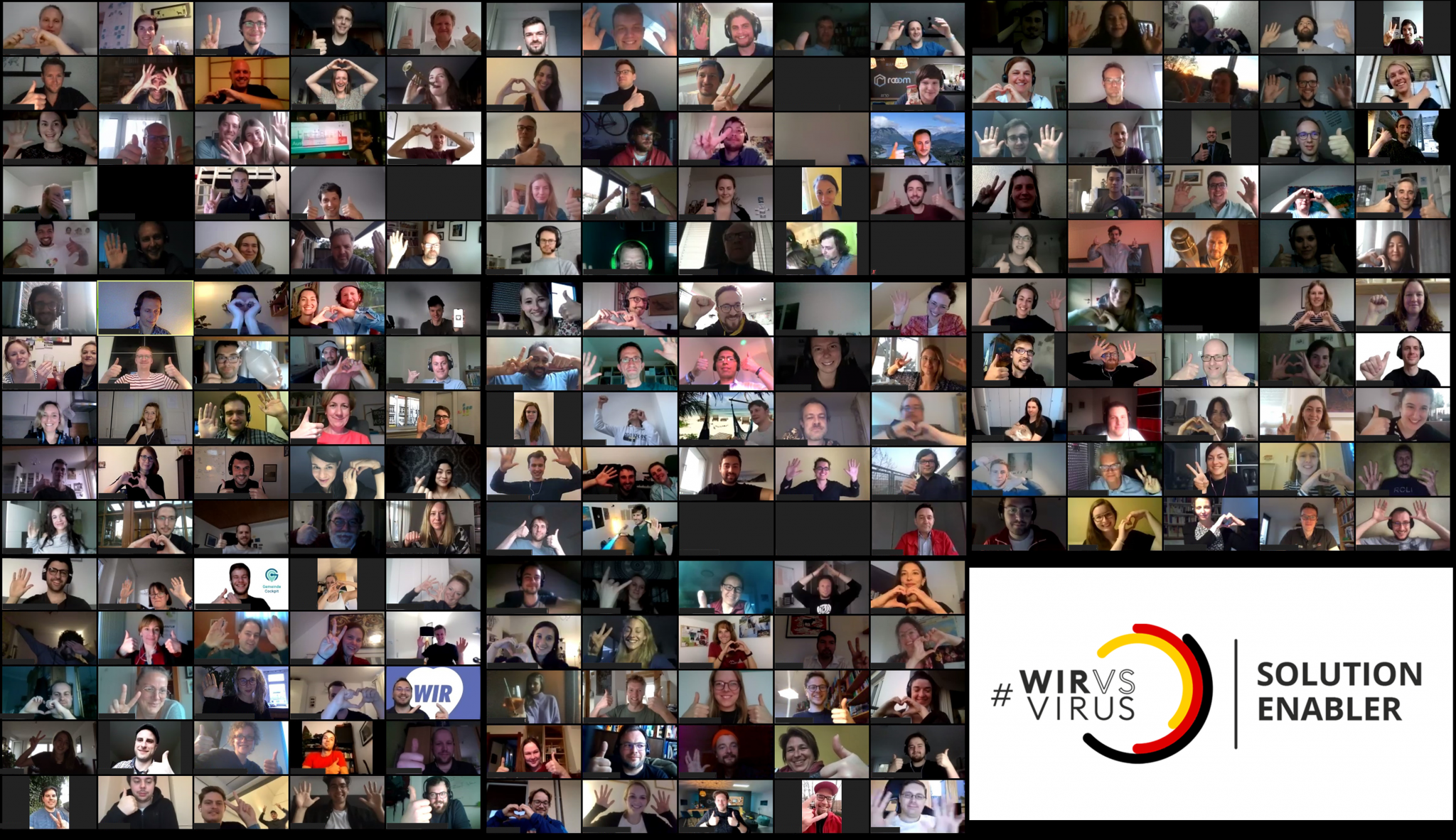Moving from sprint to marathon: Lessons learned from the German #wirvsvirus hackathon and its implementation program

This OPSI guest blog, written by Thomas Gegenhuber (Leuphana University Lüneburg/Johannes Kepler University Linz), Johanna Mair (Hertie School/Stanford University), Rene Lührsen (Hertie School/Leuphana University Lüneburg) and Laura Thäter Lührsen (Hertie School/Leuphana University Lüneburg) shares insights gathered from the #wirvsvirus hackathon on how to carry forward the ideas produced in hackathon environments into concrete action and projects.
Moving from sprint to marathon
Lessons learned from the German #wirvsvirus hackathon and its implementation program
The pandemic related to Covid-19 is a global crisis; it entails challenges that manifest in all domains of social and economic life, including but not limited to, health, education, and employment. How to address such a crisis? One approach is to devise a participatory strategy: bringing together government, business, and civil society to jointly face challenges that affect us all and develop solutions that benefit us all. In addition to relying solely on well-vetted capabilities, tools and resources, the crisis constitutes an opportunity for governments to reach out to all spheres of society to come up with ideas and solutions to cope with Covid-19 and its consequences. By opening a space for participation, governments can walk off the beaten track to identify novel solutions generated by unusual allies.
The German Federal Government did precisely that. Inspired by a crisis-spurred hackathon taking place in Estonia, a group of seven civil society organizations proposed an online hackathon in March 2020 to find solutions to the COVID-19 crisis. The German chancellery seized the opportunity and, within days, agreed to serve as the host. Germany’s first government-hosted crisis hackathon – #WirVsVirus (in English #wevsvirus) was born. The hackathon attracted citizens from all societal domains – ranging from programmers, designers, entrepreneurs, students to social workers. Overall, 26,581 people participated, making it probably the world’s largest hackathon. Over the course of 48 hours, teams generated a total of 1,494 project ideas. The #WirVsVirus Hackathon is part of a broader hackathon movement sparked through the crisis. To understand what makes this still ongoing initiative unprecedented, we need to understand the format of hackathon and its promised effects.
Hackathons: Driving social innovation or participatory illusion?
The format of ‘civic’ hackathons is already in the repertoire of many governments and public organizations. The process usually encompasses a contest-like open call for solving a particular problem, followed by individuals forming teams and working on a solution. A hackathon concludes with a ceremony awarding and celebrating the best solutions.
Whether and how hackathons constitute a viable instrument to kickstart social innovation remains unclear. Some studies suggest that hackathons indeed lead to impactful results. For example, NYU researcher Lifshitz-Assaf and her colleagues show how a hackathon resulted in viable prototypes for assistive technologies aimed to solve problems of individuals with disabilities. However, merely enabling experimentation without scaling ideas and solutions is insufficient. Critical voices point out that although hackathons create much enthusiasm, evidence on how ideas and projects get implemented after ‘civic ‘hackathons is scarce.
Setting up a support infrastructure
When the #WirVsVirus organizers developed the hackathon concept, they were well aware of the usual shortcomings of this participative instrument. To avoid the hackathon being merely a symbolic ‘spark of hope’, the organizers set up a post-hackathon support infrastructure. With this infrastructure, the organizers sought to facilitate the transition from rapid idea development during a hackathon (the sprint) to supporting teams to develop further, integrate, and scale-up their ideas (the marathon). The program started in April 2020 and will last until September 2020. The support infrastructure consists of three specific programs:
1) The Solution Enabler Program, which began two weeks after the hackathon, ensures that teams can acquire new skills (e.g. project management skills, crafting value propositions), benefit from networking opportunities (e.g. engaging in conversations with stakeholders from the public and private sector), community building (e.g. weekly online calls enhancing the community spirit), feedback on the team’s progress (e.g. mentors with domain expertise give advice), and resources (e.g. a digital platform where teams can tap into pro-bono services offered by private sector companies, such as coding or marketing support). Additionally, the organisers mobilized some financial support (e.g. small government grants) for a selected number of teams and offer scholarships for individual team members.
All teams participating in the hackathon, as well as initiatives and projects that did not attend the hackathon, could apply for this programme. From about 400 applications, the hackathon organisers accepted about 130 teams. Such a selection procedure contributes to securing commitment. This commitment is a critical factor – after all, turning an idea into a social innovation is an uphill journey.

2) The Solution Builder Program’s set-up follows the idea of an accelerator and offers hands-on resources for a small cohort of nine teams selected out of the Solution Enabler program. The organisers mobilized venture partners (e.g., venture builders and tech companies) to directly work with the teams to assist them in critical areas where resources are scarce, such as programming and IT skills. All in all, the Solution Builder aims to further establish the necessary cooperation for the testing and scaling of the innovations.
To facilitate the coordination process between the teams and corporate partners, the organisers devised a ticketing system. With the support of solution leads, teams devise a specific need statement outlining the scope and the resource demand of a task. The organisers then seek to find a match for this ticket within the pool of corporate partners.
3) The organisers created a Crowdfunding Matching Funds to provide additional financial resources to teams, testing the resonance to one’s idea and gaining visibility for one’s solution. The rationale of this program is that civil society can chip in and have a voice in the implementation of ideas. How it differs from regular crowdfunding campaigns is that once a team successfully achieves its funding goal, say 1,000 Euro, it receives an additional 25 % of the reached funding goal from the matching funds; in this example, 250 Euro. Bringing about this programme was a challenge. The organizers first started a general crowdfunding campaign to mobilize funds for the matching funds. Realising that such a campaign is too abstract to attract funding, the organisers directly approached corporate foundations and donors to feed the funds. Once they reached the goal of 200.000 Euro, teams who were part of the hackathon but also ‘external’ initiatives could start with launching crowdfunding campaigns. Since completing a crowdfunding campaign takes various skills and competencies (e.g., having a professional video, etc.), the organisers offer training sessions for the teams.
Generating impact
Through the support infrastructure the organisers created an instrument to channel and direct the energy of the participants beyond the hackathon. By offering networking opportunities (e.g. mobilizing mentors from public and private sector), the organisers brought together the teams with large-scale public and private organisations, which are critical for supporting the teams to test and scale up their ideas. Thereby the programme generated learning effects for both sides: on the one hand teams learn about the complexities of creating social innovation, on the other hand, public organisations learn from the rapid and flexible exploration approach of the teams. The support infrastructure not only mobilised resources but it was also critical to generate a sense of community and belonging (e.g. weekly meetings to learn from each other’s progress). Moreover, the federal government’s endorsement of the hackathon and the infrastructure certainly translated into legitimacy gains, which is a critical precondition for establishing collaboration with critical stakeholders.
In sum, the impact of the #wirvsvirus hackathon and its support programme is manifold: it generates hope and sense of accomplishment in difficult times; it empowers citizens to actively participate in crisis resolution, and thousands of participants have learned about new working methods and agile product development and had access to networking opportunities across sectors and political divides. Not all 1,494 ideas of the hackathon will translate in sustainable solutions. However, jointly all the teams working on those ideas have demonstrated civil society’s ability to mobilise and collaborate. Over the last months teams have produced and distributed masks (e.g., Stayhomeandsew, Vechta gegen Corona), created digital solutions improving government services and administration (e.g., U:DO, IMIS, Quarano, Wir-bleiben-liquide), built technological solutions to efficiently comply with regulatory demands for businesses offering hospitality services to consumers (e.g., Darfichrein) and supported small and medium sized-companies in reorganizing work (e.g., Mittelstandgoeshomeoffice).
A blueprint for other societal challenges?
The #wirvsvirus hackathon and its support infrastructure are undoubtedly a unique approach to enable large-scale collaboration between government, civil society, and the private sector to address societal needs. Of course, the imminent threat of the pandemic and the forced locked down mattered. Nevertheless, we believe that the combination of energised and rapid ideation combined with a support infrastructure to foster realisation is a promising, yet also a challenging, approach. The impact of hackathons extends beyond the generated solutions — such an approach creates various positive spillover effects such as meeting new people from diverse backgrounds, and learning more about the challenges of realising social innovation to plant the seed for future endeavors.












